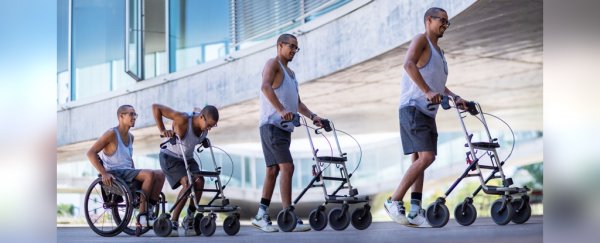A new kind of electrical stimulation technique has helped three men to walk again, delivering never-before-seen improvements in patients with spinal cord injury (SCI).
The technique, which could pave the way for new treatments for thousands of people who have lost the use of their legs, uses precisely targeted electrical stimulation delivered in patterned bursts to the spinal cord.
In two new papers outlining the work, a team led by researchers from École Polytechnique Fédérale de Lausanne in Switzerland describes how their specialised method of epidural electrical stimulation (EES) helped paraplegics to recover voluntary leg movement – even in the absence of the stimulation.
On top of that, this method worked years after the patients had sustained their injuries.
"Our findings are based on a deep understanding of the underlying mechanisms which we gained through years of research on animal models," explains senior researcher and neuroscientist Grégoire Courtine.
"We were thus able to mimic in real time how the brain naturally activates the spinal cord."
 The experimental spatiotemporal EES platform (EPFL)
The experimental spatiotemporal EES platform (EPFL)
EES, which involves implanting electrodes in the spinal column, has been investigated for several years, but up until now it's demonstrated more success in animal models of leg paralysis than in human patients.
Although the exact reasons for why EES is 'species-specific' like this remains unknown, the researchers suggest that the standard technique – called 'tonic' or 'continuous' stimulation – blocks a significant amount of proprioceptive input in humans, making it harder for people to sense their limb positions, even as the EES activates muscles.
In contrast, this new system employs a temporal sequence of spatially selective stimulation patterns – something the team calls 'spatiotemporal' stimulation, which wirelessly transmits signals to embedded implants activating different muscle groups, not only stimulating nerve connections, but prompting new nerve growth.
"This method has the advantage that specific stimulation patterns are applied at the exact time when the participant attempts to perform the associated movement," first author of one of the new papers, Fabien Wagner, explained to ScienceAlert.
"This results in a natural integration between the participant's voluntary attempts to produce a movement and the selective effects of the stimulation."
 David during EES rehab (Jean-Baptiste Mignardot)
David during EES rehab (Jean-Baptiste Mignardot)
The innovation produced almost instantaneous results in testing, with the three male patients examined in the study gaining the ability to walk (with the assistance of body-weight support) after just one week of calibration with the neurotechnology, and despite several years of chronic paralysis.
But the best was yet to come. After five months of intensive rehabilitation (at least four sessions per week), the patients could walk for one hour on a treadmill with the spatiotemporal EES without muscle exhaustion or gait impairment.
At this stage in the rehab, the men were able to show voluntary leg movement even in the absence of stimulation.
"This level of neurological recovery has never been observed in patients with chronic spinal cord injury before," Wagner says.
"We hypothesise that the coincidence between brain inputs and stimulation-induced spinal cord activation led to neuronal plasticity within residual spinal circuits, leading to the observed recovery of motor function."
In other words, the working system – effectively a technological reproduction of the brain signals that ordinarily control walking – appears to produce unprecedented levels of neurological recovery in paraplegic patients, by leveraging collateral nerves that haven't been injured.
While there's no guarantee every patient would see similar results – which take months of intensive rehab to realise – it's an incredibly positive finding that could give hopes to thousands of people who experience leg paralysis and impaired mobility.
And especially so, since the patients in the study had each sustained their spinal cord injuries more than four years before the treatment began.
That's important because in cases where a person gets SCI more recently, the researchers are confident the recovery would be stronger, "when the potential for plasticity is elevated and the neuromuscular system has not yet undergone the atrophy that follows chronic paralysis," they write.
A startup founded by two of the researchers called GTXmedical is now working on bringing the spatiotemporal stimulation to clinics and hospitals, but as Wagner explains, there are barriers of a different sort to overcome.
Before a therapy can be delivered to the public, the neurostimulation technique has to be simplified, standardised for clinical use, and validated by clinical trials that demonstrate it's safe and effective.
"It is also important to keep in mind that industrial collaborations are required to integrate technologies … in order to make this dream possible," Wagner says, although he remains cautiously optimistic.
"We expect this treatment to be available for patients in about three to five years."
In short, there's still a long way to go and a lot left to do before this research can really help people get on their feet again.
But it looks like we're closer than we've ever been.
The findings are reported in Nature and Nature Neuroscience.
